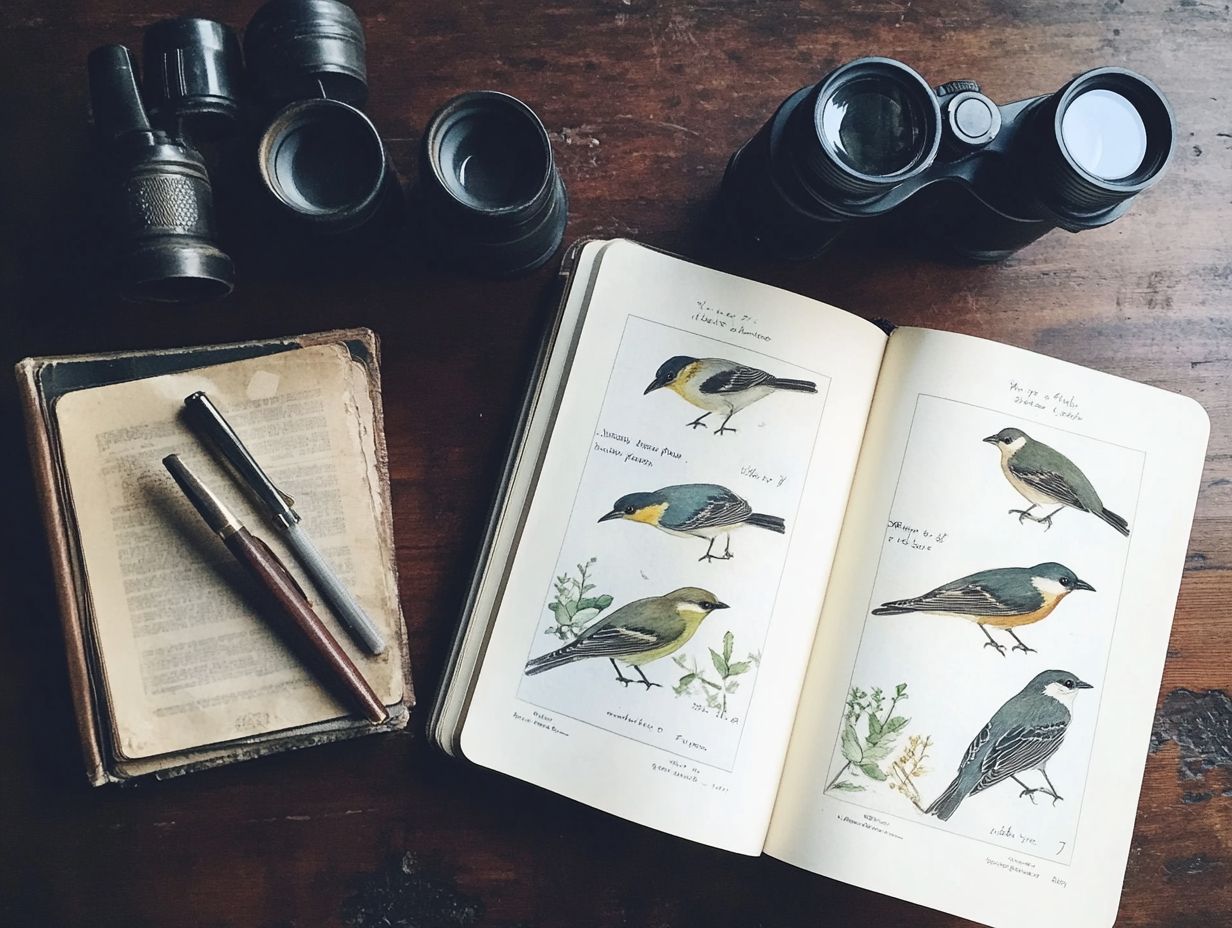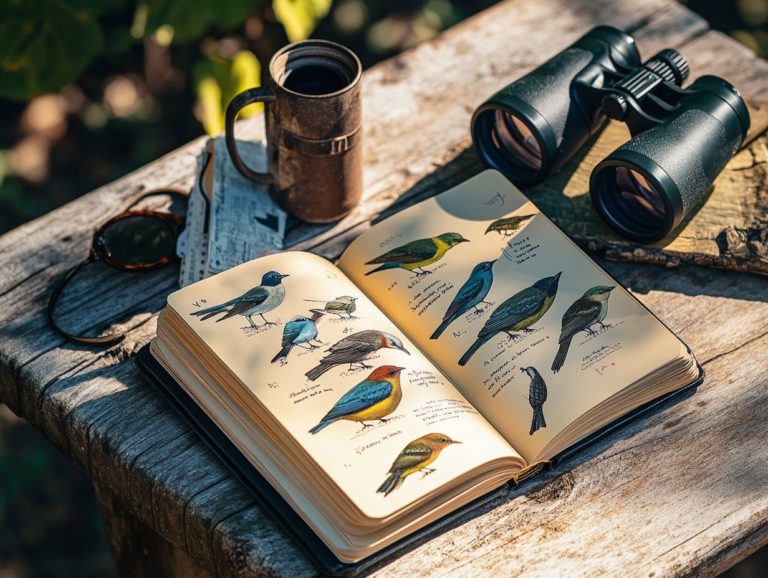Creating a Birdwatching Journal with Field Guides
Birdwatching goes beyond the simple act of spotting feathered friends; it s about forging a connection with nature and savoring those moments of pure wonder.
Maintaining a birdwatching journal elevates this experience by providing you with a canvas to document your observations and reflect on your adventures.
This article also delves into the myriad benefits of keeping a journal, guides you on how to select the ideal field guide, offers tips for organizing your notes, and shares techniques for keen observation.
It explores ways to collaborate with fellow enthusiasts. Immerse yourself to enrich your birdwatching journey!
Contents
- Key Takeaways:
- Why You Should Start a Birdwatching Journal Today!
- Choosing the Right Field Guide
- Organizing Your Birdwatching Journal
- Recording Your Observations
- Using Your Journal in the Field
- Sharing and Utilizing Your Birdwatching Journal
- Frequently Asked Questions
- What is a birdwatching journal?
- Why should I create a birdwatching journal?
- What should I include in my birdwatching journal?
- How can field guides be useful in creating a birdwatching journal?
- Do I need to be an expert in birdwatching to create a journal?
- Can I use electronic devices to create my birdwatching journal?
Key Takeaways:

- A birdwatching journal is a valuable tool for recording and organizing observations, as well as enhancing the birdwatching experience.
- When selecting a field guide, look for one that is user-friendly, comprehensive, and tailored to your geographic region or specific interests.
- Effective note-taking and sketching techniques, as well as utilizing your journal in the field, are crucial for accurately recording and identifying bird species.
Why You Should Start a Birdwatching Journal Today!
Maintaining a birdwatching journal goes beyond merely logging observations; it transforms into a personal chronicle of your avian adventures. Picture capturing significant milestones, such as spotting a Common Gull in Eastport, Maine, which might be your 700th species, while also understanding bird behavior with field guides.
Think of your journal as a blank canvas where your birdwatching dreams come to life. It allows for handwritten notes, sketches, and entries that sharpen your observational skills while enriching your bond with nature. For a deeper experience, consider exploring bird habitats with field guides.
Benefits and Uses of a Birdwatching Journal
A birdwatching journal offers a wealth of benefits that can significantly elevate your birding experience. It helps sharpen your observational skills and allows you to maintain an accurate life list a list of all the bird species you’ve seen.
By documenting each sighting and experience, you deepen your understanding and appreciation of avian life. This practice enables you to track your progress over time and makes identifying species during future outings a breeze.
With every entry, you capture unique behaviors, habitat preferences, and seasonal changes, weaving a rich tapestry of your birdwatching journeys. To enhance this experience, consider learning how to create a personalized bird field guide. Your journal serves as a powerful reflection tool, inviting you to revisit adventures and share stories with fellow enthusiasts.
Maintaining a nature journal fosters mindfulness, encouraging a deeper connection with the environment. Ultimately, the physical records you create become treasured archives, celebrating both your personal growth and the incredible diversity of bird life.
Choosing the Right Field Guide
Selecting the perfect field guide is essential for any birdwatcher aiming to elevate their species identification skills. You may lean towards the Sibley guide or the Peterson guide.
Each of these options presents distinctive features and illustrations tailored to different levels of expertise and birdwatching adventures.
What to Look for in a Field Guide
When selecting a field guide, it’s crucial to look for features that will enhance your species identification and observational skills. Look for clear illustrations, concise descriptions, and practical tips to help you distinguish between similar species.
A quality guide will also provide insight into regional variations, allowing for more accurate identification. The layout of the guide is equally important; it should facilitate quick reference in the field without overwhelming you.
Visual aids like photographs, range maps, and charts showcasing seasonal behaviors can significantly boost your ability to identify birds in real time.
Don t overlook additional resources such as QR codes that link to online databases or community forums, offering ongoing support. With a keen eye for accuracy and detail, a well-crafted field guide ultimately gives you the power to deepen your understanding and connection with nature, enriching every adventure you embark on in the wild.
Organizing Your Birdwatching Journal

Organizing your birdwatching journal with intention can significantly elevate your experience and streamline access to your observations. Whether you prefer a classic physical field notebook or a sleek digital nature journal, a thoughtful structure is key. To enhance your skills further, consider exploring field guides that build your birdwatching knowledge.
By implementing a structured layout with clear categories, you’ll find it easier to monitor your progress and identify trends throughout your birdwatching journey.
Layout and Categories
The layout and categories of your birdwatching journal are essential for crafting a personal record of your birding experiences. A well-organized journal, along with helpful field guides, makes it easy to revisit past observations and uncover patterns over time.
Consider setting up sections for the date and location. Also, include species and notes for better organization.
Beyond these fundamental categories, adding details like weather conditions, time of day, and habitat type can offer deeper insights into bird behavior and migration patterns. Including sections for sketches or photos can truly elevate your experience, allowing you to connect more vividly with the moments you’ve captured.
Creating monthly or seasonal summary pages encourages ongoing reflection and comparison. This enriches your understanding of the local bird population. Using symbols or color-coding to highlight rarer species or personal milestones transforms your journal into a captivating exploration of nature s wonders.
Recording Your Observations
Record your bird observations with precision to create a rich database of your experiences. Use effective note-taking and sketching techniques in your field notebook.
This practice sharpens your species identification skills and offers invaluable insights for your future outings.
Effective Note-taking and Sketching Techniques
Effective note-taking and sketching techniques are vital for documenting your bird observations. These practices help you capture important details like behavior, the feathers of a bird, and habitat, enhancing both accuracy and your overall birdwatching experience.
Intertwining written descriptions with illustrations creates a richer depiction of your encounters. For example, sketching the intricate patterns of a bird’s feathers often conveys subtleties that mere words might miss.
Experiment with various textures or colors to deepen your connection to the details you observe. Incorporating personal symbols or shorthand can streamline your note-taking, tailoring the process to your unique style and preferences.
This personalized approach makes documentation enjoyable and ensures that the facts remain vivid and memorable long after the moment has passed.
Using Your Journal in the Field
Use your journal effectively in the field to greatly enhance your birdwatching experience. To further improve your organization, consider learning how to organize your bird field guides. Document observations in real-time and deepen your connection with the natural world.
Incorporating expert tips and insights from the Cornell Lab of Ornithology streamlines this process, transforming it into a more enriching and rewarding endeavor.
Tips for Field Journaling

Field journaling is invaluable for birdwatchers. Implementing effective tips can significantly elevate your observational skills and the quality of your notes. For enhanced birdwatching experiences, consider using field guides as your birdwatching companion. Use bullet points for quick entries and note environmental conditions for richer insights.
Maintaining a consistent journaling schedule is crucial for developing a deeper connection with your surroundings. Dedicate a few minutes daily to write about recent sightings, behaviors, or even sounds these fleeting moments deserve your attention.
Utilizing sketches or photographs can enhance your experience, providing a visual representation of the unique birds and habitats you encounter.
Capture your emotional reactions or thoughts during your birdwatching adventures. These personal reflections help deepen your appreciation of nature and serve as a meaningful reference for future excursions.
Sharing and Utilizing Your Birdwatching Journal
Sharing and utilizing your birdwatching journal can significantly enhance your birding experience and cultivate meaningful collaborations within the birdwatching community.
Using tools like an eBird account enhances your experience. It opens up new opportunities. Embracing technology and social platforms enables you to broaden the reach of your observations and insights, connecting you with fellow enthusiasts in exciting new ways.
Collaborating with Other Birdwatchers
Collaborating with other birdwatchers can truly elevate your birdwatching experience, offering opportunities for shared learning and valuable insights, especially when you tap into platforms like eBird or resources from the Cornell Lab of Ornithology.
These partnerships can significantly broaden your understanding and refine your observational skills. By joining forces with fellow enthusiasts, you can participate in group outings that not only enhance the enjoyment of birding but also allow for the exchange of diverse techniques and perspectives.
When you contribute your data to platforms like eBird, you help create a more comprehensive understanding of local bird populations, making your efforts even more impactful.
The camaraderie and collaboration within this community transform solitary pursuits into shared adventures, unlocking new layers of excitement and knowledge as you embark on this journey together.
Frequently Asked Questions
What is a birdwatching journal?
A birdwatching journal is a record-keeping tool used by bird enthusiasts to document their observations, sightings, and experiences while birdwatching. It can take various forms, including digital journaling or using mixed media.
Why should I create a birdwatching journal?

A birdwatching journal allows you to keep track of the birds you have seen and where you saw them, which can help you identify patterns and improve your birdwatching skills. For those looking to enhance their experience, field guides: navigating the world of birds can also serve as a valuable resource, providing a personal record of your experiences in nature.
What should I include in my birdwatching journal?
You can include the date and location of your birdwatching trip, the species of birds you observed, any interesting behaviors or characteristics you noticed, and any photographs or sketches you made.
How can field guides be useful in creating a birdwatching journal?
Field guides provide information on different bird species, including their appearance, behavior, and habitats. They help you accurately identify the birds you observe and enhance your bird watching by adding more details to your journal entries.
Do I need to be an expert in birdwatching to create a journal?
No, anyone can create a birdwatching journal. It is a great tool for beginners to learn about different bird species and their behaviors, and for experienced birdwatchers to keep track of their sightings and experiences.
Can I use electronic devices to create my birdwatching journal?
Yes, you can use electronic devices such as smartphones or tablets to take notes, record sightings, and even take photos. However, many birdwatchers prefer using a traditional pen and paper journal for a more hands-on experience.
Start your birdwatching journal today to enhance your adventures!






